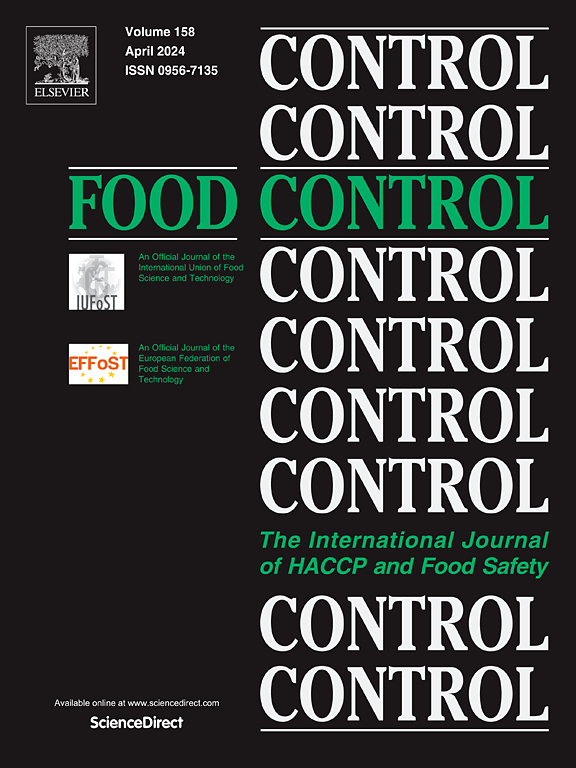Characterization and coating application of composite gelatin packaging containing eucalyptus leaf essential oil liposome and phage endolysin for preservation of pacific white shrimp (Penaeus vannamei)
IF 5.6
1区 农林科学
Q1 FOOD SCIENCE & TECHNOLOGY
引用次数: 0
Abstract
Shrimp are highly susceptible to spoilage during cold storage because of microbial growth and lipid oxidation. This study presents the development and characterization of a novel composite gelatin packaging that incorporates eucalyptus leaf essential oil liposome (EEOL) and phage endolysin (rLys). It also assesses the effectiveness of coating application for shrimp preservation to provide an effective strategy. The addition of EEOL and rLys to gelatin packaging not only enhanced film flexibility (13.16%–13.42%) and reduced oxygen permeability (0.95-0.96 × 10−7 g m−1·s−1), but also endowed the films with antioxidant (DPPH radical scavenging rate of 67.14%–67.28%) and antimicrobial properties (complete inhibition at low titers and a reduction of 3.00–4.05 log10 CFU/mL at high titers). In the shrimp coating preservation experiment, the quality of untreated shrimp started to deteriorate on the 3rd day. In contrast, the pH values, total volatile base nitrogen (TVB-N) content, and total viable count (TVC) of shrimp with the composite coatings on the 7th day were 7.28, 154.02–175.08 mg/kg, and 4.34–5.34 log10 CFU/g, respectively, remaining within the limits of the Chinese national standard. Moreover, the release of EEOL from the composite coatings led to thiobarbituric acid values (TBA) of 0.19–0.21 mg malondialdehyde (MDA)/kg on the 5th and 7th day, respectively. Additionally, rLys in the coating significantly decreased the numbers of Escherichia coli O157:H7 and Salmonella enteritidis in the shrimp body by 1.04–1.06 log10 CFU/g and 1.13–1.14 log10 CFU/g, respectively. These results suggest that the synergistic effect of EEOL and rLys in composite gelatin coating, especially the Ge-EEOL-rLys60, can extend the preservation period of shrimp to 5 d or even longer, thereby providing the possibility of maintaining shrimp freshness and safety.
含有桉叶精油脂质体和噬菌体内溶素的复合明胶包装在太平洋南美白对虾(Penaeus vannamei)保鲜中的表征和涂布应用
由于微生物生长和脂质氧化,虾在冷藏期间极易变质。本研究介绍了一种新型复合明胶包装的开发和表征,该包装结合了桉叶精油脂质体(EEOL)和噬菌体内溶素(rLys)。该研究还评估了涂层在虾类保鲜中的应用效果,以提供一种有效的策略。在明胶包装中添加 EEOL 和 rLys 不仅能增强薄膜的柔韧性(13.16%-13.42%),降低氧气渗透性(0.95-0.96 × 10-7 g m-1-s-1),还能赋予薄膜抗氧化性(DPPH 自由基清除率为 67.14%-67.28%)和抗菌性(低滴度时完全抑制,高滴度时减少 3.00-4.05 log10 CFU/mL)。在虾涂层保鲜实验中,未经处理的虾的质量在第三天开始下降。相比之下,使用复合涂层的对虾在第 7 天的 pH 值、总挥发性碱氮(TVB-N)含量和总存活数(TVC)分别为 7.28、154.02-175.08 mg/kg、4.34-5.34 log10 CFU/g,仍在中国国家标准的限制范围内。此外,复合涂层中 EEOL 的释放导致第 5 天和第 7 天的硫代巴比妥酸(TBA)值分别为 0.19-0.21 毫克丙二醛(MDA)/千克。此外,包衣中的 rLys 能显著减少虾体内大肠杆菌 O157:H7 和肠炎沙门氏菌的数量,分别减少 1.04-1.06 log10 CFU/g 和 1.13-1.14 log10 CFU/g。这些结果表明,EEOL 和 rLys 在复合明胶涂层(尤其是 Ge-EEOL-rLys60)中的协同作用可将虾的保鲜期延长至 5 d 甚至更长,从而为保持虾的新鲜度和安全性提供了可能。
本文章由计算机程序翻译,如有差异,请以英文原文为准。
求助全文
约1分钟内获得全文
求助全文
来源期刊

Food Control
工程技术-食品科技
CiteScore
12.20
自引率
6.70%
发文量
758
审稿时长
33 days
期刊介绍:
Food Control is an international journal that provides essential information for those involved in food safety and process control.
Food Control covers the below areas that relate to food process control or to food safety of human foods:
• Microbial food safety and antimicrobial systems
• Mycotoxins
• Hazard analysis, HACCP and food safety objectives
• Risk assessment, including microbial and chemical hazards
• Quality assurance
• Good manufacturing practices
• Food process systems design and control
• Food Packaging technology and materials in contact with foods
• Rapid methods of analysis and detection, including sensor technology
• Codes of practice, legislation and international harmonization
• Consumer issues
• Education, training and research needs.
The scope of Food Control is comprehensive and includes original research papers, authoritative reviews, short communications, comment articles that report on new developments in food control, and position papers.
 求助内容:
求助内容: 应助结果提醒方式:
应助结果提醒方式:


